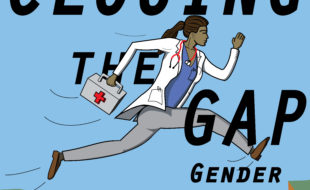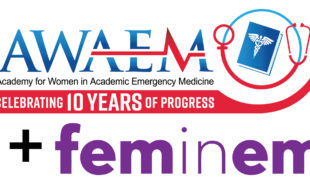Disclaimer: The view(s) expressed herein are those of the author(s) and do not reflect the official policy or position of Brooke Army Medical Center, the Department of the Air Force, the Department of Defense or its components.
Goals:
- Explore why the gender gap exists
- Discuss initial steps to combat implicit bias
Show guest:
Bias
- Defined as prejudice in favor of or against one thing, person, or group compared with another, usually in a way considered to be unfair.
- Specifically, gender bias—unequal treatment in employment opportunity (such as promotion, pay, benefits and privileges), and expectations due to attitudes based on the sex of an employee or group of employees.
- Implicit bias is the unconscious attribution of particular qualities to a member of a certain social group
- Harvard’s Project Implicit is a free website where you check your own biases
- Gender career test is the most applicable
Molly Carnes Interview
- Initially only woman with tenure in medicine at University of Wisconsin
- Closed her lab and then dedicated her research into what is keeping women in medicine from advancing their careers
- Implicit bias was non-existent when she started in medicine—bias was overt. Repeatedly told that she was taking the place from a man and was questioned why she went into medicine if all she’s going to do is quit in a few years to have babies
- Transition of gender bias from explicit to implicit
- Initially assumed with Title IX that equilibration would transpire
- Has been ongoing and progressive but has been over decades
- Research has now repeatedly shown no difference between female and male physicians1
- Sex segregation remains present
- 4% of practicing interventional cardiologists are women
- Humans have both explicit and implicit biases. Understanding and accepting this is crucial to eliminating them.
- Breaking the Bias Habit
- Collaboration with Patricia Devine, psychologist at University of Wisconsin
- Akin to quitting smoking, extensive and involved cultural shift
- 46 of the 92 departments at the University of Wisconsin underwent the workshop2
- 3 years later reviewed institutional data
- Higher retention rates for male faculty
- Gender parity for new hires for those departments that underwent workshop but for those that did have the workshop the hiring rate for women remained at 32%
- Women who have a supportive structure in their workplace are more likely to state they have an appropriate work/life balance even if they are working up to 70 hours a week.
- Women who did not feel supported reported a poor work/life balance even if they were working 40 hours per week3
- Bias Reduction in Internal Medicine (BRIM) initiative is ongoing and aims to see if the breaking the bias approach works beyond gender and at other institutions
- Stereotype threat
- Initially termed by Claude Steele
- If you’re a member of group that is negatively stereotyped you may underperform implicitly to conform to the stereotype
- Men and women harbor the same implicit biases against women
- Initial strategies to curb implicit bias
- Challenge the stereotypes when they’re identifies
- Increasing transparency in attempt to not permit inequalities to persist
- Open books for finances to hopefully decrease the gender pay gap, which has been shown to be an average of $18,677.23 per year4 in primary care specialties
References
- Tsugawa, Yusuke, et al. “Comparison of Hospital Mortality and Readmission Rates for Medicare Patients Treated by Male vs Female Physicians.”JAMA Internal Medicine, U.S. National Library of Medicine, 1 Feb. 2017, ncbi.nlm.nih.gov/pmc/articles/PMC5558155/.
- Carnes, Molly, et al. “The Effect of an Intervention to Break the Gender Bias Habit for Faculty at One Institution: a Cluster Randomized, Controlled Trial.”Academic Medicine : Journal of the Association of American Medical Colleges, U.S. National Library of Medicine, Feb. 2015, ncbi.nlm.nih.gov/pmc/articles/PMC4310758/.
- Westring, Alyssa Friede, et al. “Culture Matters: the Pivotal Role of Culture for Women’s Careers in Academic Medicine.”Academic Medicine : Journal of the Association of American Medical Colleges, Published for the Association of American Medical Colleges by Lippincott Williams & Wilkins, Apr. 2014, ncbi.nlm.nih.gov/pubmed/24556773.
- Desai, Tejas, et al. “Equal Work for Unequal Pay: the Gender Reimbursement Gap for Healthcare Providers in the United States.”Postgraduate Medical Journal, U.S. National Library of Medicine, Oct. 2016, www.ncbi.nlm.nih.gov/pubmed/27528703.
Podcast: Play in new window | Download











